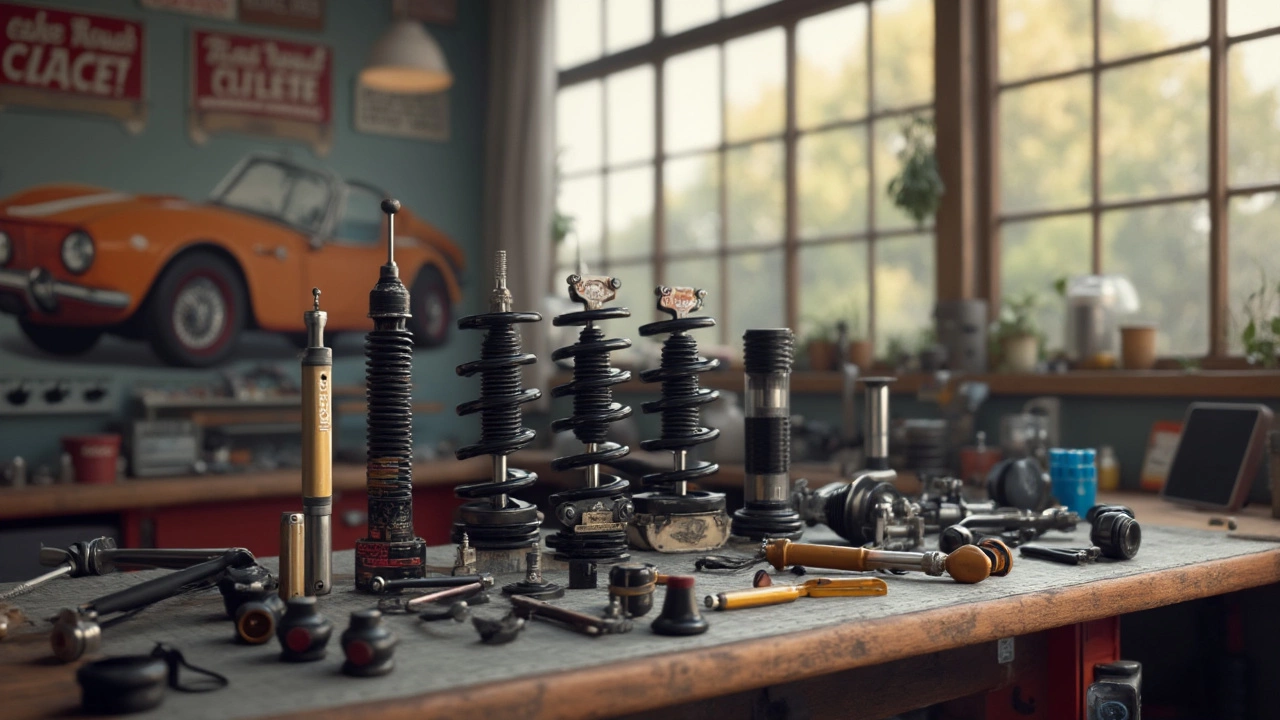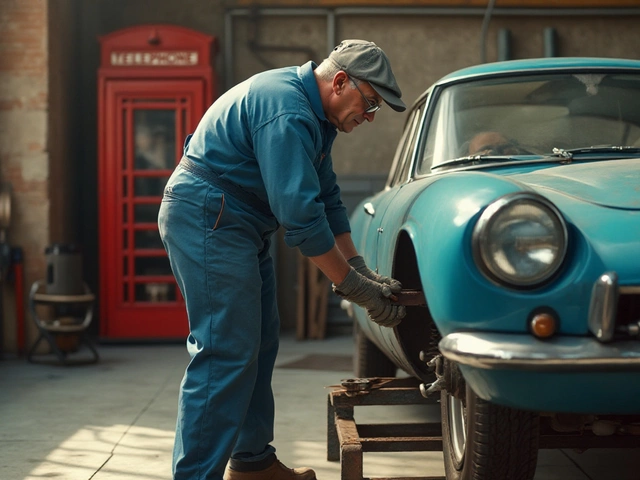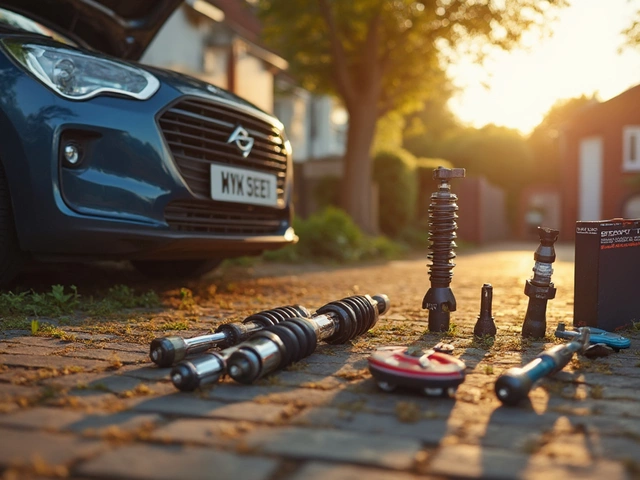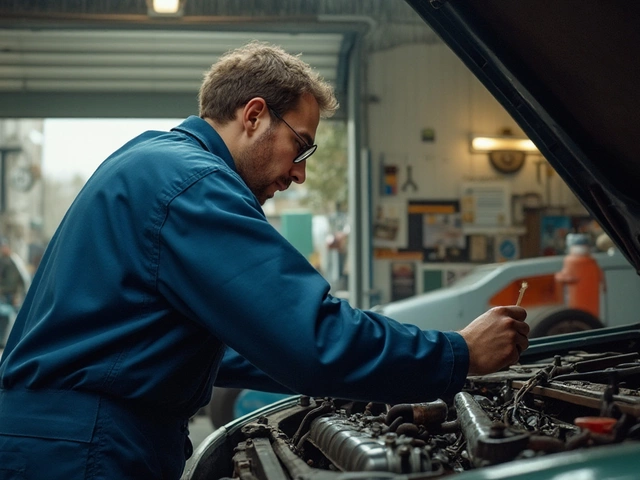Ever wonder what actually keeps your car stable every time you hit a pothole or take a sharp turn? Unless you're into cars, the stuff going on underneath might seem like black magic. But knowing a little about your suspension pays off—both in comfort and in cash. When mechanics toss around terms like 'struts' or 'control arms,' most folks just nod and hope for the best. It doesn't have to be that way.
Your suspension is basically the middleman between the frame of your car and the road. Its job? Keep tires glued to the pavement, absorb bad roads, and make your steering predictable. All those metal arms, rubber mounts, and chunky springs are doing some serious work—silently, every single drive. Learning what each part does means you'll know when something feels off, and maybe even catch a minor fix before it becomes a wallet-buster.
- What Suspension Really Does
- Springs: The Unsung Heroes
- Shocks and Struts: Controlling the Bounce
- Control Arms and Ball Joints: Guiding the Wheels
- Bushings, Mounts, and Other Details
- Spotting Trouble Before It Gets Serious
What Suspension Really Does
Your car’s suspension isn’t just there to make the ride softer. It’s what really keeps your tires in steady contact with the road. Without it, you’d feel every single crack, pothole, and speed bump like a punch to the gut, and your car would be nearly impossible to steer or stop safely. So it’s not just about comfort—it’s about control and safety.
The main jobs of your suspension are:
- suspension parts hold up the weight of the car and passengers.
- Keep tires pressed firmly to the ground, which is key for braking and turning.
- Soak up road shocks, like potholes and bumps, so they don’t slam through to your seat.
- Help with steering by letting the wheels move up and down independently.
Here’s how much work your suspension does on a regular drive:
| Situation | Suspension Movement (approx) |
|---|---|
| Highway driving (smooth) | 1,000 movements per mile |
| City streets (average condition) | 3,000+ movements per mile |
| Bumpy/rural roads | Up to 5,000 movements per mile |
All those movements add up. That’s why suspension isn’t just a set-and-forget system. If something wears out or breaks, you might start to notice weird clunks, extra bouncing, or even uneven tire wear. If your car suddenly feels floaty after hitting a bump, that’s a big red flag that one of these parts is getting tired. It’s always smart to pay attention early so you’re not stuck with even pricier fixes down the line.
Springs: The Unsung Heroes
Springs are the backbone of your suspension parts. It doesn't matter if you’re driving a tiny hatchback or a big truck—every vehicle needs springs to deal with bumps, dips, and rough patches. Without them, every little pothole would rattle your teeth.
There are a few main types of springs you’ll find under cars:
- Coil Springs: These look like big, heavy-duty versions of the ones in a ballpoint pen. Most modern cars use them.
- Leaf Springs: Think stacks of metal strips—a classic choice for trucks and older vehicles because they handle big loads.
- Torsion Bars: These twist under pressure and are common on some SUVs and pickups.
- Air Springs: Some higher-end cars and trucks use airbags for a cushy ride and adjustable height.
Your springs buffer the car’s frame from everything the road throws at it. They give the wheels room to move up and down, which means less shudder through the steering wheel. That’s key for road safety and for keeping your tires in steady contact with the ground.
| Type | Typical Vehicles | Notable Benefit |
|---|---|---|
| Coil Spring | Sedans, SUVs, compact cars | Great for smooth rides |
| Leaf Spring | Pickup trucks, vans, old classics | Good for heavy loads |
| Torsion Bar | Some 4x4s, SUVs | Height adjustable |
| Air Spring | Luxury cars, modern trucks | Adjustable comfort, load leveling |
If you ever notice the car sitting low on one side, or you hear loud clunks from the corners when driving over bumps, it’s time to look at your springs. Don’t ignore sagging—it puts extra strain on other suspension parts and makes handling unpredictable. Ever ride in a car that bounces like a trampoline after every bump? That’s usually tired or broken springs. If you haul heavy stuff or live somewhere with rough roads, checking your springs for rust and cracks at every oil change is a smart move.
Shocks and Struts: Controlling the Bounce
If you’ve ever felt your car bounce too much after hitting a bump, odds are it’s time to look at your shocks or struts. These two are often confused, but here’s the simple difference: shocks just control up-and-down movement, while struts combine that job with supporting some of your vehicle’s weight. In many cars these days, you’ll find struts up front and shocks in the back.
Shocks and struts calm down your suspension, turning rough roads into bearable drives. Without them, every bump would send your car bouncing like a low-rider. Here’s what they do specifically:
- Absorb and slow down spring movement after a bump, settling the car quickly.
- Keep the tires pressed to the pavement, which is super important for braking and steering.
- Prevent your car from rocking back and forth or side to side through turns or stops.
Here’s a cool thing: most newer shocks use gas (like nitrogen) instead of just oil, which cuts down on foaming and keeps performance sharp even on rough roads. Expect shocks and struts to last anywhere from 50,000 to 100,000 miles, but rough drivers or those with bad roads can wear them out quicker.
| Part | Average Lifespan | Replacement Cost (per piece) |
|---|---|---|
| Shock Absorber | 50,000 - 100,000 miles | $50 - $150 |
| Strut Assembly | 50,000 - 100,000 miles | $150 - $300 |
A quick test? Push down hard on your car’s front or rear bumper and let go. If it bounces more than two or three times, your shocks or struts might be tired. It’s also smart to check if your car nose-dives when braking or sways through corners. Any of these signs mean a visit to your mechanic is in order. Always remember, when the suspension parts in charge of controlling the bounce are worn out, your ride isn’t just uncomfortable—it can also get dangerous fast.

Control Arms and Ball Joints: Guiding the Wheels
Control arms and ball joints do a ton of the heavy lifting when it comes to keeping your wheels pointed the right way. Think of control arms like sturdy metal levers. They're the link between your car’s frame and your wheels. Most cars have either two control arms per wheel—one upper and one lower—or just a single lower arm in the front. Trucks and SUVs often use the double-arm setup for extra toughness, especially when tackling rough roads.
Each control arm pivots up and down whenever you hit a bump or make a turn. They let your wheels move independently while staying lined up. At the end of every control arm is a ball joint—a kind of tough, swiveling socket (imagine your hip joint). Ball joints let your wheels steer left and right, and move up and down at the same time. If they start to wear out, you’ll hear clunks, feel sloppy steering, or even get uneven tire wear. That’s your car’s way of saying, “Get this fixed, please!”
It’s pretty common for these parts to need replacing, especially if your routes involve potholes, curbs, or winter salt. One AAA study found that 44% of car owners had to deal with suspension problems at least once, with ball joints and control arms near the top of the list.
Here’s a breakdown of how these important suspension parts come together:
- Control Arms: Usually shaped like a letter “A.” Made from steel or aluminum. Responsible for holding the wheel to the car and allowing up and down smooth movement.
- Ball Joints: Bulb-shaped ends filled with tough grease, allowing the wheels to pivot it all directions without binding.
- Bushings: Flexible pieces, almost like rubber donuts, keep the metal from clanking together and absorb tiny shocks.
Wondering what could go wrong? Here are a few warning signs your control arms or ball joints are waving a red flag:
- Wheel shakes at higher speeds
- Uneven tire wear, especially on the inside or outside edges
- Loud clunk or thud noise when you go over bumps
- Loose or wandering steering feel
If you’re shopping for replacement parts, check for options made from forged steel or heavy-duty aluminum—these tend to last longer, especially if you drive in tough conditions.
| Part | Average Lifespan (miles) | Replacement Cost (USD) |
|---|---|---|
| Control Arm | 90,000 – 120,000 | $180 – $400 (each) |
| Ball Joint | 70,000 – 100,000 | $100 – $250 (each) |
Keeping these parts healthy means your car steers straight, rides quiet, and keeps tire costs down. If you ever hear a weird noise or get loose steering, don’t ignore it—your suspension is telling you something important.
Bushings, Mounts, and Other Details
These parts might not look like much, but bushings and mounts are the unsung workhorses of your suspension parts. Without them, every bump would rattle your car to pieces. Bushings are usually made of rubber or polyurethane and act like cushions between metal pieces. They soak up vibration, cut back on noise, and help keep alignment in check. Most common spots for bushings? Control arms, sway bars, and shock mounts.
Mounts do for your suspension what your shoes do for your feet—provide a buffer between the hard stuff and the stuff that needs protection. Shock mounts and strut mounts hold the dampers in place and absorb hits from the road, stopping that energy from rattling your car’s frame—or your teeth.
Here’s what else you’ll find hidden underneath:
- Ball joint boots: Keep grease in and gunk out, protecting your ball joints from early wear.
- Dust covers and bump stops: Stop debris from damaging key parts and keep your shocks from bottoming out.
- Subframe bushings: These isolate the whole subframe from the body, reducing road noise and harshness.
According to Car and Driver, "Worn bushings may not seem like a major problem, but they can throw off suspension alignment and cause weird noises or sloppy steering."
"A small, cracked bushing can be the difference between a crisp steering response and that unnerving clunk over every bump." – Car and Driver
Wondering if your bushings or mounts are shot? Look out for these signs:
- Clunks or rattles over bumps
- Steering that feels loose or drifts
- Uneven tire wear
- More vibrations in the cabin
Changing bushings can make your car handle tighter and feel almost new. Polyurethane bushings, for example, last much longer than rubber ones. But they might make the ride a bit stiffer. Worth thinking about if you’re getting them swapped out.
Here’s a quick cheat sheet for common bushing materials:
| Material | Typical Lifespan | Ride Quality |
|---|---|---|
| Rubber | 50,000-100,000 miles | Softer, more forgiving |
| Polyurethane | 100,000+ miles | Firmer, possibly more road feel |
If you notice steering issues or odd noises, don’t ignore them. These little parts might sound boring, but they take a beating every day and can really mess with how your car drives when they go bad.
Spotting Trouble Before It Gets Serious
If you want to avoid nasty repair bills or sudden highway surprises, it helps to spot worn suspension parts early. Some issues are easy to notice even if you don't know a ratchet from a screwdriver. Pay attention to subtle changes in how your car handles or rides—your butt and your ears are better sensors than you think.
- Weird noises when driving over bumps: A knocking or clunking sound probably means a ball joint, bushing, or mount is shot.
- Excessive bouncing: Push down on the hood or trunk. If your car keeps bouncing after one or two rebounds, your shocks or struts might be toast.
- Car pulls to one side: This can point to worn control arms or a broken spring.
- Uneven tire wear: If your tires look shredded on one edge, that’s often from a bad suspension part throwing the wheels out of alignment.
- Steering feels loose or sloppy: Worn tie rods, ball joints, or bushings are all suspects.
If you catch problems early, you might pay $180 to swap a set of bushings. Ignore the noise, and you’ll be forking over $900 or more when related parts fail from extra stress. Here’s a ballpark repair cost comparison for common suspension jobs:
| Suspension Repair | Average Cost (USD) |
|---|---|
| Replace struts/shocks | $400–$900 (all four) |
| Replace control arms | $300–$700 (pair) |
| Replace bushings | $150–$350 |
| Replace ball joints | $200–$400 (pair) |
Driving with bad suspension is not just uncomfortable—it messes up handling and braking. That means safety is on the line. If you hear a suspicious noise or feel the car acting weird, get it checked before a minor bump becomes a major headache.






